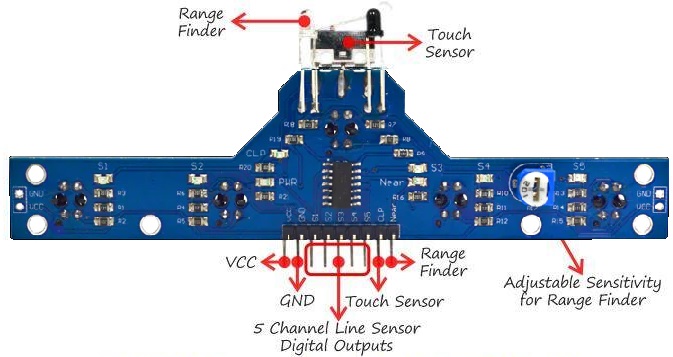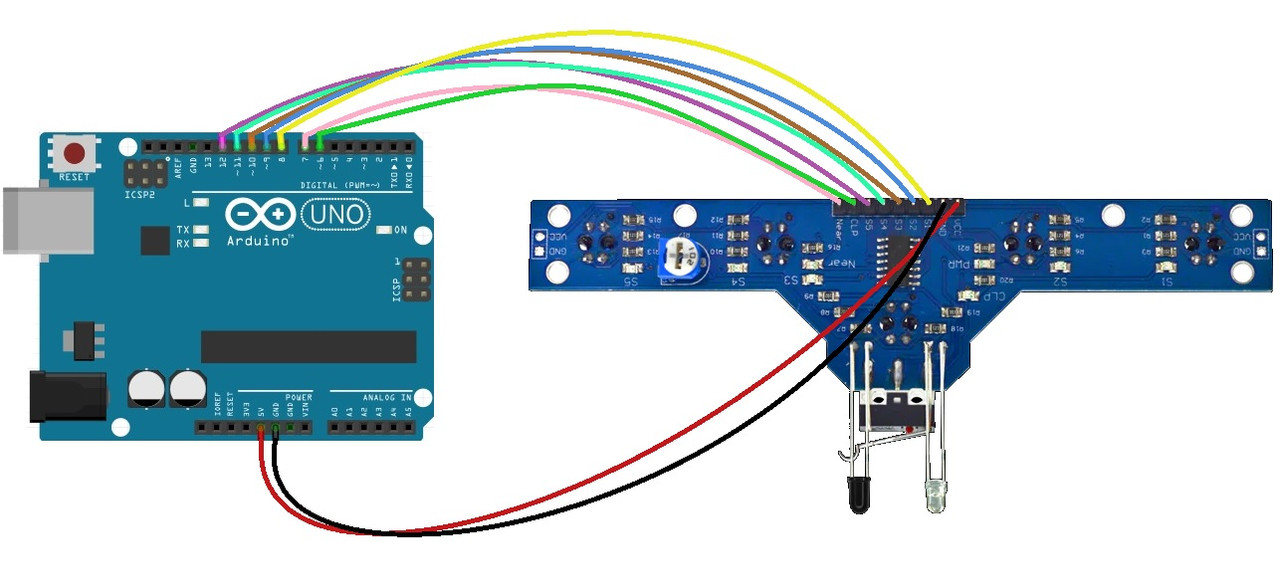AED 30.45
Description
The BFD-1000 sensor module is a multi-sensor module that includes 5 TCRT5000 sensors for line following and black road detection/tracking, one IR proximity sensor at the front, and a limit switch for detecting obstacles in front of the robot. It has a detection range of 0-4cm for the TCRT5000 sensors and 0-5cm for the front proximity sensor. The module operates on an input voltage of 3.0V-5.5V and outputs digital signals (high and low level) that can be easily connected to a microcontroller. The sensor has LED lights as indicators for easy debugging and can detect lines with a sensitivity range of 0.5mm-40mm without any adjustment. The BFD-1000 sensor module simplifies the design of line-following robots and is ideal for the accurate tracking of black lines.
Package Includes:
- 1 x BFD-1000 Line Follower 5Ch Infrared Tracking Sensor Module
Features:
- 5 TCRT5000 sensors: The module has five TCRT5000 sensors that can be used to detect a black or white line. These sensors have a detection range of 0-4cm and are highly sensitive, making them ideal for line following.
- IR proximity sensor: The module also has an IR proximity sensor that can be used to detect obstacles in front of the robot. This sensor has an adjustable detection range of 0-5cm.
- Limit switch: The module has a limit switch that can be used to detect obstacles in front of the robot. This switch is designed to provide information to the robot in case the front sensor fails or there is an obstacle in front of it.
- Digital output: The module outputs digital signals (high and low level) that can be easily connected to a microcontroller.
- LED indicators: The module has LED lights that can be used as indicators for easy debugging.
- Wide voltage range: The module supports a voltage range of 3.0V-5.5V, which means that it can be used with a wide range of microcontrollers and other devices.
- Special touch sensor design: The module is designed with a special touch sensor design that makes it easy to use and connect to a microcontroller.
- High sensitivity: The module has a high sensitivity range of 0.5mm-40mm, which means that it can detect lines with high precision without requiring any adjustment.
Description:
The BFD-1000 sensor module is a multi-sensor module that can be used to create a line follower robot that can accurately track a black or white line. The module is designed with 5 TCRT5000 sensors for line tracking and black road detection and an IR proximity sensor in the front. This combination of sensors makes it easy to create a robot that can accurately follow a line, even on complex tracks, The TCRT5000 sensors are designed to detect the contrast between a black line and a white background, which makes them ideal for line following. They have a detection range of 0-4cm, which means that they can detect the line even when it is very close to the ground. The sensors are also highly sensitive and can detect lines with a sensitivity range of 0.5mm-40mm without any adjustment. The front IR proximity sensor is designed to detect obstacles in front of the robot. It has an adjustable detection range of 0-5cm, which means that it can detect obstacles at varying distances. The sensor operates on an input voltage of 3.0V-5.5V and outputs digital signals (high and low level) that can be easily connected to a microcontroller. The module also has LED lights as indicators for easy debugging. The BFD-1000 sensor module is designed with a special touch sensor design, which simplifies the robot's design. The sensor outputs all digital signals, which makes it easy to connect to a microcontroller. The module also supports a voltage of 3.0-5.5V, which means that it can meet any system requirements.
Principle of Work:
The BFD-1000 sensor module operates using two main components: the TCRT5000 sensors and the touch sensor in the front. The TCRT5000 sensors are infrared sensors that can detect changes in reflectivity. These sensors consist of an infrared LED and a phototransistor. When the LED emits light, the phototransistor detects how much of that light is reflected back. If the sensor is placed over a black line, for example, the light will be absorbed by the black surface, resulting in a low signal from the phototransistor. If the sensor is over a white surface, more of the light will be reflected back, resulting in a higher signal from the phototransistor. The BFD-1000 module has five TCRT5000 sensors that are positioned in a line, allowing the robot to detect a black or white line more accurately. By using multiple sensors, the robot can detect the line from multiple angles and improve its ability to stay on the line. If one sensor loses the line, the robot can use the other sensors to maintain its position. The touch sensor in the front of the BFD-1000 module allows the robot to detect obstacles in its path. The sensor works by using a simple switch that is triggered when the robot comes into contact with an obstacle. When the switch is triggered, the robot can change its behavior and take appropriate action, such as stopping or moving around the obstacle.
Pinout of the Module:

- VCC: This pin should be connected to a positive voltage supply between 3.0V and 5.5V.
- GND: This pin should be connected to the ground.
- S1: This pin is the output for the first TCRT5000 sensor.
- S2: This pin is the output for the second TCRT5000 sensor.
- S3: This pin is the output for the third TCRT5000 sensor.
- S4: This pin is the output for the fourth TCRT5000 sensor.
- S5: This pin is the output for the fifth TCRT5000 sensor.
- CLP: This pin is the output for the touch sensor.
- Range finder: This pin is the output for the front IR proximity sensor.
Applications:
- Line-following robots: The BFD-1000 module is ideal for building robots that can follow a black line on a white background or a white line on a black background. This is useful for applications such as warehouse automation, where robots can navigate through a facility and transport goods.
- Obstacle detection: The front IR proximity sensor can be used to detect obstacles in the robot's path. This is useful for applications such as robot vacuum cleaners or autonomous vehicles, where the robot needs to avoid obstacles to navigate through an environment.
- Edge detection: The BFD-1000 module can also be used to detect the edges of a surface. This is useful for applications such as industrial robots or CNC machines, where the robot needs to stay within a specific area of a workpiece.
- Position tracking: The BFD-1000 module can be used to track the position of a robot or other device. This is useful for applications such as tracking the position of a conveyor belt in a factory or monitoring the position of a robotic arm.
Circuit:

- VCC pin of the module to 5V pin of Arduino
- GND pin of the module to the GND pin of the Arduino
- S1 to digital pin 8 of Arduino
- S2 to digital pin 9 of Arduino
- S3 to digital pin 10 of Arduino
- S4 to digital pin 11 of Arduino
- S5 to digital pin 12 of Arduino
- CLP to digital pin 6 of Arduino
- Range finder sensor to digital pin 7
Library:
No need for a library to work with this module.
Code:
A basic code forreading the sensor values from the BFD-1000 module and displaying them over serial:
const int line_pin[5] = {8, 9, 10, 11, 12};
const int near_pin = 7;
const int clp_pin = 6;
int line_val[5] = {0};
int near_val = 0;
int clp_val = 0;
void setup() {
Serial.begin(9600);
for (int i = 0; i < 5; i++) {
pinMode(line_pin[i], INPUT);
}
pinMode(near_pin, INPUT);
pinMode(clp_pin, INPUT);
}
void loop() {
read_sensor();
display_serial();
}
void display_serial() {
for (int i = 0; i < 5; i++) {
Serial.print(line_val[i]);
Serial.print(" ");
}
Serial.print(near_val);
Serial.print(" ");
Serial.println(clp_val);
delay(1000);
}
void read_sensor() {
for (int i = 0; i < 5; i++) {
line_val[i] = digitalRead(line_pin[i]);
}
near_val = digitalRead(near_pin);
clp_val = digitalRead(clp_pin);
}
- The first 6 lines of the code define the pins that the sensors are connected to. The 5-line sensors are connected to pins 8-12, the proximity sensor is connected to pin 7, and the touch sensor is connected to pin 6.
- In the setup function, the code initializes the serial communication with a baud rate of 9600 and sets the pin modes for the sensors as input.
- In the loop function, the code calls the read_sensor function and then the display_serial function.
- The read_sensor function uses a for loop to read the values of each of the 5 line sensors, the proximity sensor, and the touch sensor and stores these values in corresponding variables.
- The display_serial function then prints out the values of the sensors to the serial monitor. It does this by using another for loop to iterate through the line_val array and printing out each value, followed by printing the values of the proximity sensor and the touch sensor.
- The code then adds a delay of 1000ms (1 second) before starting over again.
Technical Details:
- Input voltage: 3.0V - 5.5V DC
- Output form: Digital output (high or low level)
- Detection distance:
- TCRT5000 black and white line sensors: 0-4cm
- IR proximity sensor: 0-5cm
- Sensing range for tracking: 0.5mm-40mm without any adjustment
- Number of infrared sensors: 5 (TCRT5000 sensors)
- Additional sensors: 1 IR proximity sensor and 1 touch sensor for detecting obstacles
- LED indicators for easy debugging
- Dimensions: 45mm x 26mm x 9mm
Resources:
Comparisons:
The TCRT5000 BFD-1000 module and the 1-channel TCRT5000 module both use the same TCRT5000 infrared sensor for detecting lines. However, the TCRT5000 BFD-1000 module has some additional features that make it more versatile and useful for more complex robotics applications. Here are some key differences:
- The TCRT5000 BFD-1000 module has five TCRT5000 sensors, whereas the 1-channel TCRT5000 module has only one sensor. This allows the BFD-1000 module to detect lines more accurately and follow more complex line patterns, such as curves or intersections.
- The BFD-1000 module also has an IR proximity sensor and a touch sensor for detecting obstacles, which is not present in the 1-channel TCRT5000 module. This makes the BFD-1000 module more suitable for obstacle avoidance and other applications where detecting objects is important.
- The BFD-1000 module has LED indicators for easy debugging, which is not present in the 1-channel TCRT5000 module. This makes it easier to diagnose problems and troubleshoot issues during development.
- Both modules have digital outputs, but the BFD-1000 module has more pins to connect, as it has additional sensors. This may require more complex wiring and connections, but it also provides more flexibility in terms of how the sensors are used and connected to the rest of the system.
While the 1-channel TCRT5000 module is a simple and affordable option for basic line-following applications, the TCRT5000 BFD-1000 module offers more features and flexibility for more advanced robotics projects.